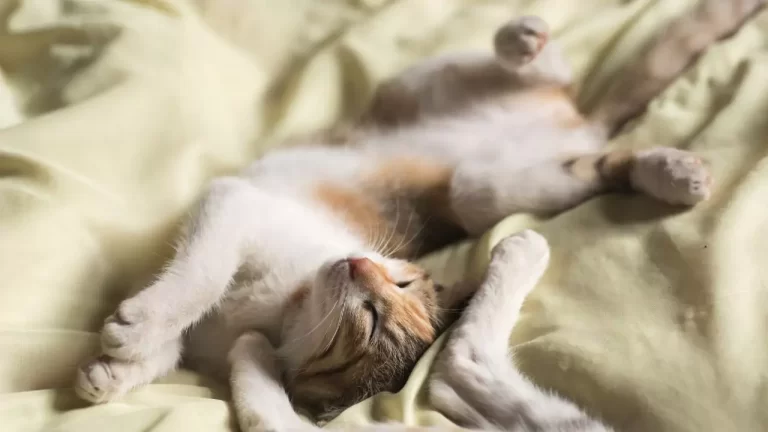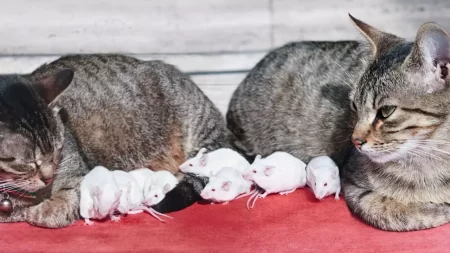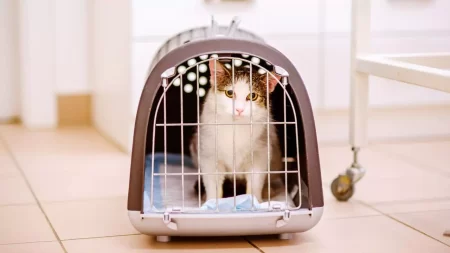Cats are often mysterious creatures, but their sleeping positions can reveal a lot about how they’re feeling and how they view their relationship with their owners.
If your cat sleeps on your bed, you’re in luck, because it’s a sign that they trust you and feel safe and comfortable around you.
However, the exact spot on your bed where they choose to sleep can also provide additional insights into their personality and needs.
Understanding Cat Sleeping Positions and Behavior
Different Cat Sleeping Positions and What They Could Mean
Here are some of the most common cat sleeping positions and what they could mean:
- Curled up in a ball: This is a very common sleeping position for cats, and it suggests that they feel safe and secure.
- Sprawled out on their back: This position is often seen as a sign of contentment and relaxation.
- On their side: This is another common sleeping position that suggests that your cat is feeling comfortable and safe.
- On your chest: This is a very affectionate sleeping position, and it shows that your cat trusts you and feels close to you.
- Under the covers: This position could mean that your cat is looking for extra warmth or security.
- At the foot of the bed: This position could suggest that your cat wants to be close to you, but they also need some space.
- At the head of the bed: This position could mean that your cat is keeping an eye on their surroundings or that they wants to be close to you for comfort.
How a cat’s sleeping position can reflect their bond with their owner?
The more affectionate and trusting a cat feels towards their owner, the more likely they are to sleep close to them. For example, a cat that sleeps on their owner’s chest or under the covers with them shows a great deal of trust and affection.
Possible Reasons Behind Cats Sleeping on Your Bed
There are many reasons why cats choose to sleep on their owners’ beds. Some of the most common reasons include:
- Affectional instincts: Cats are social creatures, and they crave companionship and affection. Sleeping on their owner’s bed is a way for them to show their love and trust.
- Comfort and warmth: Human beds are typically warm and comfortable, making them an ideal place for cats to sleep.
- Sense of security: Cats feel safe and secure when they are close to their owners. Sleeping on their owner’s bed gives them a sense of comfort and protection.
- Emotional balance: Sharing a bed with their owner can help cats feel emotionally balanced and reduce stress.
Advantages of Letting Your Cat Sleep on Your Bed
There are many advantages to letting your cat sleep on your bed. Some of the most notable benefits include:
- Strengthening the bond between owner and cat: Sharing a bed with your cat can help to strengthen the bond between you. It is a way to show your cat that you love and trust them.
- Improved sleep quality for both parties: Studies have shown that people who sleep with their pets tend to sleep better. This is likely due to the sense of comfort and security that pets provide.
- Emotional benefits for the cat: Sleeping with their owner can help cats feel emotionally balanced and reduce stress. It can also help to reduce anxiety and loneliness.
Tips for Understanding and Interpreting Cat Sleeping Positions
Here are a few tips for understanding and interpreting cat sleeping positions:
- Observe behavior over time: It’s important to observe your cat’s sleeping behavior over time to get a better understanding of what it means. For example, if your cat only sleeps on your chest when they are feeling stressed, it’s a sign that they seek comfort from you.
- Consider a cat’s personality and needs: Every cat is different, so it’s important to consider their individual personality and needs when interpreting their sleeping positions. For example, some cats are more independent than others and may prefer to sleep in a separate space.
- Seek veterinary advice if necessary: If you are concerned about your cat’s sleeping behavior, it’s always best to consult with a veterinarian. They can help you rule out any underlying medical conditions and provide guidance on how to best support your cat’s needs.
Conclusion
Understanding your cat’s sleeping positions can help you to learn more about their personality and needs. It can also help you to identify any potential problems or concerns. If you notice any changes in your cat’s sleeping behavior, it’s important to talk to your veterinarian.







